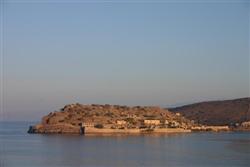
The picturesque village of Plaka is located just 3km from Elounda in eastern Crete about
1 hours drive from Heraklion airport. It is situated opposite the famous Venetian fortress
island of Spinalonga, well known through films such (Who pays the Ferryman) and more recently
through Victoria Hislops fictional novel
. The large sheltered bay fronting Plaka,
Elounda and the larger town of Agios Nikolaos approximately 10km away is known since Venetian
times as the Gulf of Mirabello or 'beautiful view'.
Crete was the home of Europe's first civilisation which flourished here from around 3000 BC.
Remains of this Minoan culture can be visited in the museums of Agios Nikolaos and Heraklion
and of their impressive palaces at the sites of Malia, Kato Zakros and more famously Knossos
approximately 1 hour away by car. The Minoan culture was taken over peacefully by the Mycenaean's
around 1450 BC. Remains of this culture can be seen in the well preserved Dromos tombs south of
Heraklion. The Mycenaean empire ended around 1200 BC under attack from the so called "sea people"
that also seized the Hittie empire and even threatened the eqyptian empire. (Crete is located
about 350 km N/W of Egypt. The years that followed were known by historians as the 'dark ages'.
The age of Homer (8th century) gave birth to the irse of the famous classic greek civilisation
that culminated in the 4th century BC in the '300 Cities of Crete. According to the classic
Greek civilisation, Crete was known as the birth place of Zeus. (You can visit his reported
birth place the 'Dikteon Cave in the Lassithi plains approximately 90 minutes drive from Plaka).
In ancient greek times Elounda was known by the name of 'Olous'. The city was sited on the
area between the sheltering island directly in front of Plaka and the mainland. The remains
of this ancient city have since sunk into the sea hence its name the 'sunken city of Olous'
sections of which are still just visible from the surface of the water.
Crete was later conquered by the romans when the apostle Paul was ship-wrecked in southern
rete on his journey to rome. Crete was a Roman province for over 100 years. After Constantine
the Great it remained part of the east Roman Empire of Byzantium and many churches on Crete
date back to Byzantium times. A wonderful example is the beautiful church of Panagia Kera with
its colourful frescoes in the village of Kritsa, approximately 20minutes from Plaka. Arabic
troops followed in the 7th century AD conquering Crete and thus putting an end to the Byzantium
Empire. According to legend the palm trees on the Palm Beach at Vai supposedly originated from
date stones spat out from the Arabic invaders. These Arabic conquerors burned their ships on
landing in order to destroy all means of retreat. In 1204 AD the Venetians took control of
the island. They renamed it 'Chandia' meaning 'White'. The Venetian rule lasted for 465 years
and brought prosperity, culture and the building of great fortresses, roads and harbours. Handsome
mansions, buildings and fountains from this era still remain all over the island, the most famous
of which being the fortress of Spinalonga, built in 1579 on the picturesque island immediately in
front of the villa. This fortress remained one of the island's most formidable strongholds long
after the Turkish invasion in the 15th century and only handed over by treaty in 1715. The Turkish
occupancy lasted for 400 years. Turkish settlers built homes there and refused to leave after
Greece won independence. The government persuaded them to go by designating Spinalonga a leper
colony in 1903. It was the last of its kind in Europe and existed until it was evacuated in 1957.
It was known locally as 'the island of the living dead'. The approach to the island by fishing
boat is stunning and there are wonderful views from the ramparts.